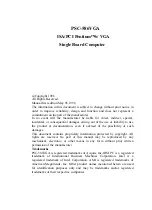
Using the Assembler/Disassembler
Introduction
Included in the PME68/Monitor firmware is an assembler/disassembler. This is a dy-
namic assembler/editor in which the source program is not saved. Each source line is
translated into the proper 68000 machine language code and is stored in memory on a
line-by-line basis at the time of entry. To display an instruction, the machine code is
disassembled and the instruction mnemonic and operands are displayed. All valid 68000
instructions are translated.
The assembler does not allow line numbers and labels; it processes each line of program
as an individual unit. However, it is a powerful tool for creating, modifying, and
debugging 68000 code.
The limitations of one-line assemblers are:
(a) Label and line numbers are not allowed. Labels are commonly used to reference
other lines and locations in a program. The one-line assembler has no knowledge
of other program lines and therefore cannot make the required association
between a label and a label definition located on a separate line.
(b) Source lines are not saved. In order to read back a program after it has been
entered, the machine code is disassembled and then displayed as mnemonic and
operands.
(c) Limited error indication. The one-line assembler will show a question mark (?)
under the portion of the source statement where an error probably occurred, or
will display the word "ERROR" or another message.
(d) Only one directive (DC.W) is accepted.
(e) No macro handling capability is included.
(f) No conditional assembly can be used.
68000 Assembly Language
The symbolic language used to code source programs for processing by the assembler is
called "68000 Assembly Language". This is a collection of mnemonics representing:
(a) Operations
- 68000 machine instruction operation codes
- Directive (pseudo-op)
(b) Operators
(c)
Special symbols
PME68-1B Manual
Page 107 Issue 5
Содержание PME 68-1B
Страница 8: ...Figure 1 The PME 68 1B Board Photograph not available in PDF PME 68 1B Manual Page 2 Issue 5...
Страница 12: ...Figure 4 Component Layout Diagram P5 P4 P3 BAT PME 68 1B Manual Page 6 Issue 5...
Страница 56: ...Figure 14 Link Areas BAT PME68 1B Manual Page 50 Issue 5...
Страница 57: ...Blank Page PME68 1B Manual Page 51 Issue 5...
Страница 59: ...Figure 15 Location of System EPROM Area 1 2 3 4 1 2 3 4 WC1 WC2 PME68 1B Manual Page 53 Issue 5...
Страница 80: ...Figure 41 Location of BERR Jumpers 1 2 3 4 WK1 WK2 BR26 2 3 1 BAT PME68 1B Manual Page 74 Issue 5...
Страница 132: ...Blank Page PME68 1B Manual Page 126 Issue 5...


































